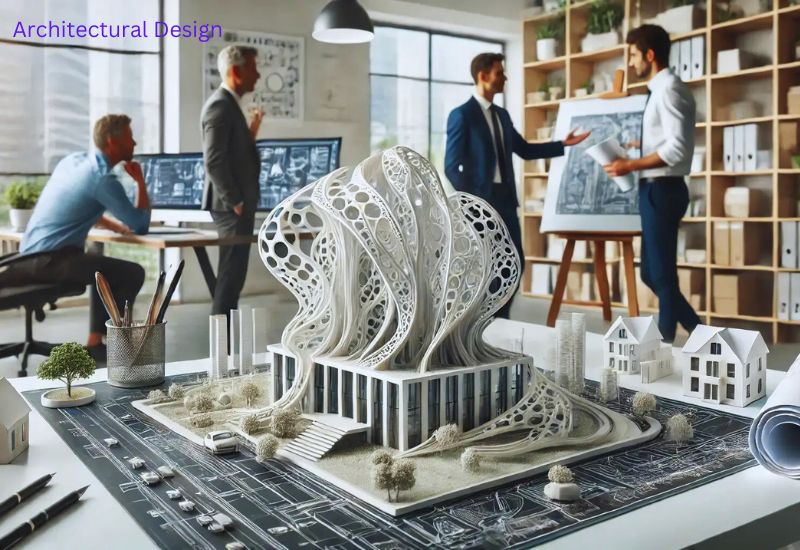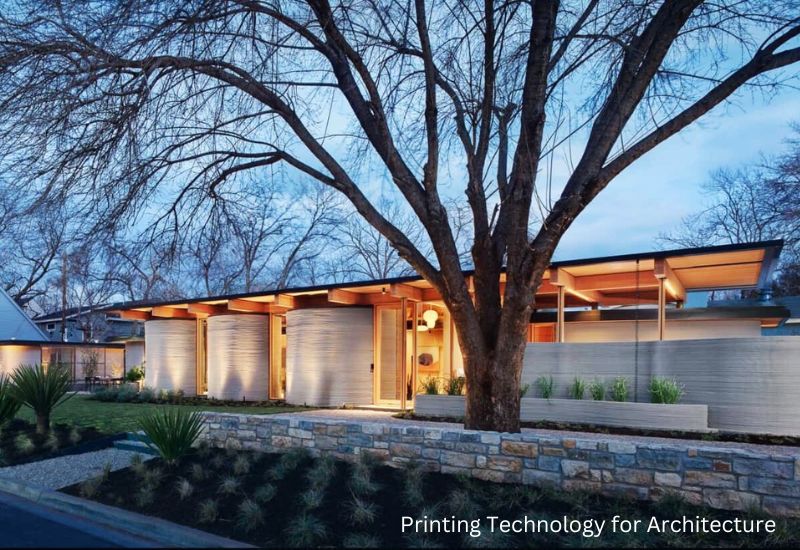3D Printing in Architecture: The 3D printing construction Market is expected to grow by nearly 91% by 2028, making it a favorable time to invest in this disruptive technology. With its cost-effective and environmentally friendly solutions, 3D printing is poised to revolutionize architecture.
As a 3D printing expert, I have witnessed firsthand how 3D printing can revolutionize design, increase resource efficiency, and produce advanced designs. 3D printers have revolutionized architecture.

Benefits of 3D Printing in Architectural Design
Speed and Efficiency
Standard models take time to make, but 3D printing changes the scale and impact of architecture. Although this technology has been around for years, most people ignore its potential to revolutionize structure overnight. A structure can now be built in hours rather than weeks or even days.
It has been confirmed that 3D technology helped build the first house of the YHNOVA project in France in only 54 hours, proving just how fast and efficient this method can be—especially for those looking to Make Money from a 3D Printer through innovative construction or design services.
As a result, 3D modeling enables the creation of structures in less time, facilitates more spontaneous communication, and fosters the development of a variety of ideas.
Lower material costs and waste reduction
Architects consider 3D printing a cost-effective and resource-conserving technology. Since only the essential resources are used, it helps reduce expenditures.
Prototyping is made easier with 3D printing since the prototypes cost less, and architects can reach their deadlines faster.
Architects can provide their clients with more sustainable designs at a lower cost by utilizing 3D printing technology.
Enhanced Design Flexibility
This technology converts pictorial ideas into precise models, enabling architects to create more detailed and complex designs.
The 3D printing process reduces the time it takes to design and modify new models, eliminating bottlenecks and constraints. This technology is now available to private clients.
An architect’s portfolio does not include similar projects. 3D printing simplifies the design of facades and joints and enhances the functional capabilities of structural models.
Architecture designs benefit from the use of 3D printing because it offers new, fast, precise, and flexible options—especially when paired with the best 3d printer for small business use.

Applications of 3D Printing in Architecture
Architectural Model Making
3D printing has transformed the field of creating architectural models. These models are highly detailed and precise, enabling customers to view the designs with greater clarity. Clients can keep track of their projects more easily.
With 3D printed models, you can enhance communication and customer satisfaction while also saving time and costs.
3D printing enables architects to showcase their work quickly. Architects can illustrate details they would not be able to demonstrate otherwise or deal with a design issue more quickly. Besides providing a perfect understanding of the designs, 3D printing models demonstrate an experience that is easy to grasp.
Full-Scale Construction with 3D Printing
The construction process will be much faster and more cost-effective thanks to 3D printing.
Examples of 3D-Printed Buildings
Using three-dimensional printing technology, a five-story house was constructed using cement and glass fibers in China.
The Dubai city administration is using 3D construction printing to layer concrete as part of its green architecture and construction plan.
Materials Used in 3D Printing
Concrete is the most popular material for 3D printing due to its durability, high compressive strength, and fire resistance. However, newer types of concrete, such as geopolymer concrete, are also used.
Modern building techniques can use natural resources, as demonstrated by the Tecla project in Italy, which used regional clay to construct eco-friendly buildings.
Looking Ahead
Architects will also be able to use eco-friendly materials and personalize their buildings with new forms of 3D printing as technology evolves.
Sustainable Architecture
A 3D printer uses only the necessary materials. Conventional construction practices waste a lot.
3D printing can also be used to produce green materials, such as lightweight, powerful polymers that use less energy to manufacture and transport than cement.
Using recycled or biodegradable materials can reduce waste and greenhouse gas emissions. The advancements in 3D printing enable designers and builders to be more innovative and create eco-friendly buildings. Thus, 3D printing can be a valuable tool in building toward sustainability.

Choosing the Right 3D Printing Technology for Architecture
Overview of Popular Technologies
Several technologies are being used in 3D printing in architecture, including:
Stereolithography (SLA): This technique uses ultraviolet light to solidify resin for accurate models and client showcases.
Fused Deposition Modeling (FDM): This method uses a thermoplastic filament that is melted and then layered to make significant, robust, and more convenient-to-test models.
Selective Laser Sintering (SLS) uses a laser to create intricate shapes without support. However, the parts remain unfinished.
Binder Jetting: The technique involves binding powder materials with liquid. Binder jetting is the best method of creating these models. Due to their fragile nature, such components should only be exhibited.
Technology can provide architects with innovation while outperforming traditional constraints.
Comparing Technologies
Mass customization architecture has its own advantages and disadvantages, depending on the 3D printing technology used.
Stereolithography (SLA): With its high layer accuracy, fine surface texture, and high cost, SLA is ideal for intricate designs.
Fused Deposition Modeling (FDM) enables the rapid construction of concept models, whereas other techniques require more detailed designs.
Selective Laser Sintering (SLS) can create large, sophisticated, self-supporting structures. However, if the cost is prohibitive, the surface would need to be repaired.
Binder Jetting: Although it is fast, the components it produces are brittle and porous, making it suitable only for display applications.
Project requirements determine technology selection in terms of detail, cost, and time.
Printing Architecture
Iconic Projects
A Chinese company called WinSun used a massive 3D printer to build five-story apartments using 3D printing architecture. The process is both cost-effective and time-saving, utilizing recycled waste and glass fiber.
Dubai Construction’s 3D-printed municipal building is another marvel that shows how 3D technology can reduce labor costs and waste.
It is evident that 3D printing construction reduces building time and cost, and also has a lower environmental impact compared to conventional construction methods in Africa.
Emerging Trends
Unique Insights and Future Perspectives
Architects can now leverage generative AI to create architecture that is both efficient and visually appealing, thanks to the ability to print 3D architectural models.
Producing bioplastics and other biodegradable materials from combustible waste improves the environment and enhances economic performance.
Robotics, automation, and 3D printing are also useful in disaster areas that are difficult to access.
As 3D printing is cheaper and has a broader range of materials, it is more appropriate for multistorey buildings in the future.
Integration with Other Technologies
3D printing and real-time rendering are both complicated technologies, so combining them would improve the accuracy of the designs.
A significant advantage of 3D printing is its ability to rapidly create models, while rendering allows for swift changes in view. This method simplifies the actual implementation process.
It enables clients to stay informed about model details and maintain their attention. It also makes it easier to comment to each other.
Architects use these technologies to visualize ideas and apply them during project completion. This results in a faster and more aesthetic outcome.
A 3D printer and real-time rendering help improve every step of the design cycle, resulting in improved designs and happy customers.
Overcoming Challenges
Current legislation does not adequately protect 3D printing procedures, so applications in construction are unlikely to succeed.
The International Code Council developed building standards for 3D-printed structures.
Developers and governing bodies should support a successful partnership, as should building inspectors and architects. Buildings could become more innovative and diverse through the adoption of 3D printing, which would change these codifications.

Future Outlook
The use of 3D printing techniques in architecture is expected to grow in the future. The construction 3D printing market is expected to reach $47.95 million by 2030, driven by its ability to create durable and cost-effective buildings.
Predictions for Growth
By 2025, 3D printers are expected to be available at construction sites, potentially increasing productivity by up to 60%.
Addressing Global Housing Challenges
The ability of 3D printing to drastically reduce the time and expense of construction is a huge benefit. Since scales can be printed in just days, they become readily available. This is particularly important when catastrophes strike in locations where soft infrastructure needs to be reconstructed quickly.
Overcoming Construction Inefficiencies
As manufacturing and construction industries generate waste and destruction, 3D printing enables the construction of buildings more sustainably. Due to a shortage of materials, cities will expand, leading to the construction of new homes.
Wrapping Up
3D printers revolutionize construction by offering affordable, sustainable, and creative alternatives. As a result, elaborate patterns can now be designed and implemented with minimal resources. As 3D printing expands, its impact on architecture will continue to grow.
Technologies like this bring good news to the world, as they allow for an infinite number of design and building options while addressing environmental concerns and enhancing creativity and innovation in the construction industry. This transformation will redefine the construction industry.
What is 3D printing in architecture?
It’s using additive manufacturing to create architectural components or whole structures—layer by layer—from materials like concrete, polymers, or composites.
What materials are used for 3D-printed buildings?
Common ones include special concrete mixes, polymers, recycled plastics, and sustainable concrete blends.
What are the advantages of 3D printing architecture?
Faster build times, less material waste, complex geometries, and potentially lower labor costs.
What are the limitations and challenges?
High upfront investment, limited large-scale material options, regulatory hurdles, and concerns about structural integrity and long-term durability.
Are 3D printed structures safe and code-compliant?
Not always yet. Many regions lack specific building codes for 3D printed components, so approval depends on local regulations and material testing.
How large can 3D printed buildings be?
Size depends on the printer’s reach and the project plan. Some firms print walls or sections on-site or prefabricate parts to assemble larger structures.
Does 3D printing reduce construction waste?
Yes — by using only the necessary materials, optimizing shapes, and recycling waste materials, it reduces leftover or cut-off pieces.
How does weather or environment impact 3D printing construction?
Quite a lot. Temperature, humidity, and weather exposure affect curing, layer adhesion, and material strength, especially for concrete prints.
What cost savings can 3D printing bring?
Savings come in reduced labor, faster construction, less formwork, and lower material waste. However, initial machinery and material costs can offset savings.
What is the future of 3D printing in modern construction?
Expect more sustainable materials, improved printers for larger scale, clearer regulations, and integration of robotics, AI, and prefab methods.

Comments are closed.